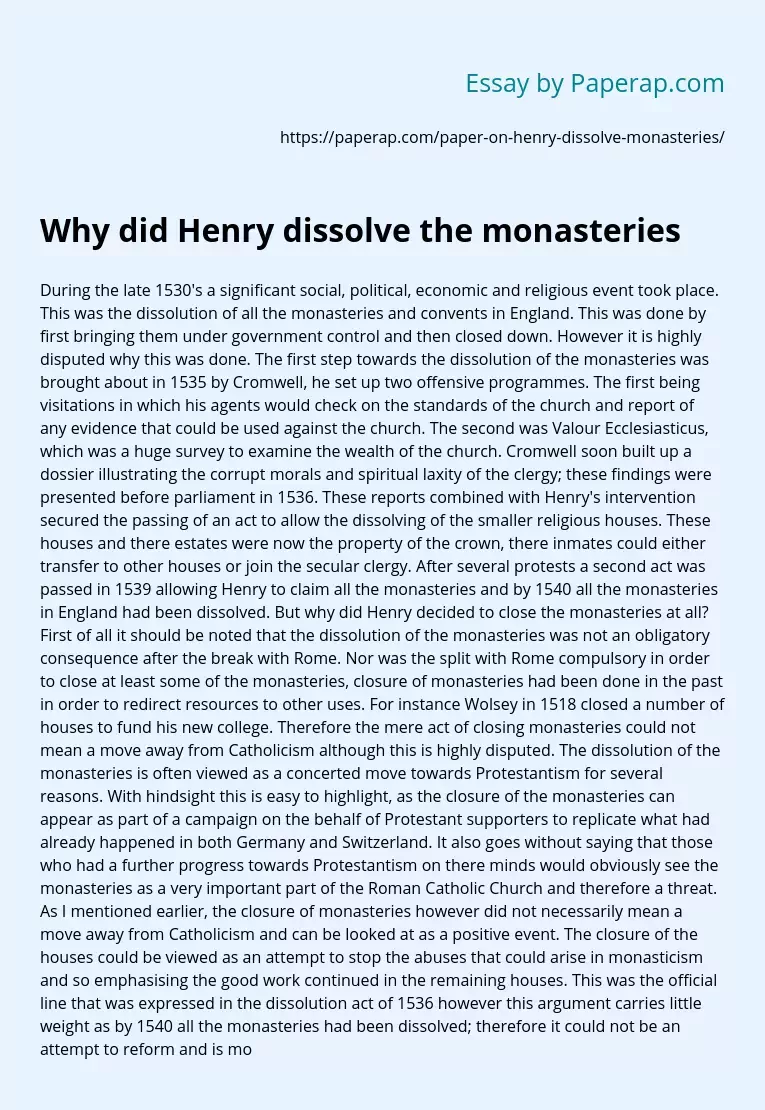Why did Henry dissolve the monasteries
During the late 1530’s a significant social, political, economic and religious event took place. This was the dissolution of all the monasteries and convents in England. This was done by first bringing them under government control and then closed down. However it is highly disputed why this was done. The first step towards the dissolution of the monasteries was brought about in 1535 by Cromwell, he set up two offensive programmes. The first being visitations in which his agents would check on the standards of the church and report of any evidence that could be used against the church.
The second was Valour Ecclesiasticus, which was a huge survey to examine the wealth of the church. Cromwell soon built up a dossier illustrating the corrupt morals and spiritual laxity of the clergy; these findings were presented before parliament in 1536. These reports combined with Henry’s intervention secured the passing of an act to allow the dissolving of the smaller religious houses. These houses and there estates were now the property of the crown, there inmates could either transfer to other houses or join the secular clergy.
After several protests a second act was passed in 1539 allowing Henry to claim all the monasteries and by 1540 all the monasteries in England had been dissolved. But why did Henry decided to close the monasteries at all? First of all it should be noted that the dissolution of the monasteries was not an obligatory consequence after the break with Rome. Nor was the split with Rome compulsory in order to close at least some of the monasteries, closure of monasteries had been done in the past in order to redirect resources to other uses.
For instance Wolsey in 1518 closed a number of houses to fund his new college. Therefore the mere act of closing monasteries could not mean a move away from Catholicism although this is highly disputed. The dissolution of the monasteries is often viewed as a concerted move towards Protestantism for several reasons. With hindsight this is easy to highlight, as the closure of the monasteries can appear as part of a campaign on the behalf of Protestant supporters to replicate what had already happened in both Germany and Switzerland.
It also goes without saying that those who had a further progress towards Protestantism on there minds would obviously see the monasteries as a very important part of the Roman Catholic Church and therefore a threat. As I mentioned earlier, the closure of monasteries however did not necessarily mean a move away from Catholicism and can be looked at as a positive event. The closure of the houses could be viewed as an attempt to stop the abuses that could arise in monasticism and so emphasising the good work continued in the remaining houses.
This was the official line that was expressed in the dissolution act of 1536 however this argument carries little weight as by 1540 all the monasteries had been dissolved; therefore it could not be an attempt to reform and is more likely a resolute move towards Protestantism. It is also widely held that the conditions in the church at this time were over exaggerated and abuses and corruption were not common, it is often thought that visitations were rigged and the evidence compiled and presented to parliament was misleading. One of the most supported theories of the dissolution of the monasteries was Henry’s need for money.
There was no doubt that the church was significantly wealthy. This is supported by plan devised in 1534 but never put into action, it was suggested that bishops should be paid salaries and monasteries would be granted money based on the number of inmates. All income of the church would therefore be taken by the crown. The plan was too radical but it shows that by the 1530’s the church was being seen as a potential source of money and by this time it was greatly needed. The value of English money was still falling, the buying power of English coins declined and the kings income stretched less and less far.
Both Spain and France were considerably greater, wealthily, catholic powers. The pope could easily ask one to attack England and overthrow Henry. Henry needed ships and coastal defences however he had very little money to pay for them. The monasteries owned vast lands and were extremely affluent. Whether the monasteries were really in a bad state or this was over embellished is unclear but monastic life was now old fashioned and writers such as Erasmus had taught many to be scornful of it. From 1536 to Henry’s death over 1. 3 million pounds was made from the dissolution.
This figure was likely to be a large factor in Henry’s decision to dissolve. It is indubitable that one of the main reasons the dissolution began was due to financial issues, however the question has to be asked whether Henry planned complete termination from the start? The words in the dissolution act of 1536 would seem to deny this. I would assert that Henry began the closure of the lesser monasteries to promote reform and to raise revenue however his greedy personality and his Protestant minister persuaded him to continue with complete dissolution.
Professor Scarisbrick would disagree by stating that ‘any plan should be kept secret and the first move should be given the impression of just reform. Reassuring the clergy and winning over their trust with a barrage of promises. Henry’s failure to live up to these promises suggested that he had practised what he now preached. ‘ However it is still unclear whether Henry was lead to dissolution by Cromwell or whether it was Henry that held the Mens rea.
Why did Henry dissolve the monasteries. (2017, Sep 04). Retrieved from https://paperap.com/paper-on-henry-dissolve-monasteries/

